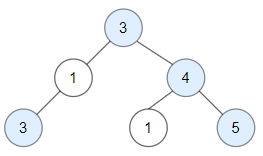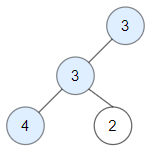Given a binary tree
root, a node X in the tree is named good if in the path from root to X there are no nodes with a value greater than X.Return the number of good nodes in the binary tree.
Example 1:

Input: root = [3,1,4,3,null,1,5]
Output: 4
Explanation: Nodes in blue are good.
Root Node (3) is always a good node.
Node 4 -> (3,4) is the maximum value in the path starting from the root.
Node 5 -> (3,4,5) is the maximum value in the path
Node 3 -> (3,1,3) is the maximum value in the path.
Example 2:

Input: root = [3,3,null,4,2]
Output: 3
Explanation: Node 2 -> (3, 3, 2) is not good, because “3” is higher than it.
Example 3:
Input: root = [1]
Output: 1
Explanation: Root is considered as good.
Constraints:
The number of nodes in the binary tree is in the range
[1, 10^5].
Each node’s value is between [-10^4, 10^4].题目大意:
一个节点是good表示该节点从root到自己的路径上,所有节点都小于等于自己。求二叉树的good节点个数
解题思路:
统计左右子树的good节点个数,最重要是引入类似于min, max验证BST,引入path_max来记录路径上的最大值,只要该节点值大于path_max就是good节点。DFS返回good节点个数
解题步骤:
N/A
注意事项:
- 引入path_max来记录路径上的最大值
Python代码:
1 | def goodNodes(self, root: TreeNode) -> int: |
算法分析:
时间复杂度为O(n),空间复杂度O(1)



